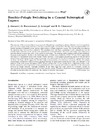Identificador persistente para citar o vincular este elemento:
https://accedacris.ulpgc.es/jspui/handle/10553/51670
| Título: | Benthic-pelagic switching in a coastal subtropical lagoon | Autores/as: | Almunia, J. Basterretxea, G. Arístegui, J. Ulanowicz, R. E. |
Clasificación UNESCO: | 251001 Oceanografía biológica | Palabras clave: | Modelling Ecosystems Eutrophication Coastal lagoons Canary Islands |
Fecha de publicación: | 1999 | Editor/a: | 0272-7714 | Publicación seriada: | Estuarine, Coastal and Shelf Science | Resumen: | The structure of the ecosystem fluxes occurring in the Maspalomas coastal lagoon (Canary Islands) were investigated for three successive stages using estimates of the food webs that typify each interval. The first stage was representative of a benthic producer-dominated system and the third typified a pelagic-dominated system. The second phase was taken as the transient stage between these endpoints. The standing stocks and fluxes pertaining to each compartment and the overall trophic structure of the system were quantified as a network model. This food web budget was subjected to network analysis to assess the status of the system at each stage. The ensuing trophic analysis indicated that detritivory increases in passing from the first to the third stage (ratio of detritivory to herbivory 13·19, 7·57 and 20·32 respectively) and there is a concomitant drop in the average trophic efficiency. Cycle analysis revealed an increase in the amount of matter being cycled during the third stage (percentages of cycled matter 17·7%, 22·6% and 41·8% respectively), mostly via short, fast loops, which suggest that the third stage is representative of an immature ecosystem. Finally, the analysis of topological system-level indices reveals a dramatic increase in organization during the last stage, due primarily to the inflation of the total system throughput (TST). From a global point of view, results show a significant decline in the benthic subsystem, which represents a major perturbation to the ecosystem and renders it vulnerable to the subsequent invasion by pelagic elements. Although conditions in the third stage may seem typical of a eutrophic system, no appreciable resources are being added to the system from the outside. Therefore, the process is more accurately described as a shift in resources from one subsystem (the benthic) to another (the pelagic). | URI: | https://accedacris.ulpgc.es/handle/10553/51670 | ISSN: | 0272-7714 | DOI: | 10.1006/ecss.1999.0503 | Fuente: | Estuarine, Coastal and Shelf Science [ISSN 0272-7714], v. 49, p. 363-384 |
| Colección: | Artículos |
Citas SCOPUSTM
61
actualizado el 08-jun-2025
Citas de WEB OF SCIENCETM
Citations
53
actualizado el 08-jun-2025
Visitas
90
actualizado el 14-dic-2024
Descargas
225
actualizado el 14-dic-2024
Google ScholarTM
Verifica
Altmetric
Comparte
Exporta metadatos
Los elementos en ULPGC accedaCRIS están protegidos por derechos de autor con todos los derechos reservados, a menos que se indique lo contrario.
